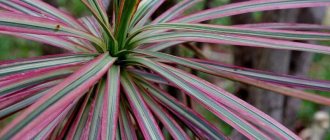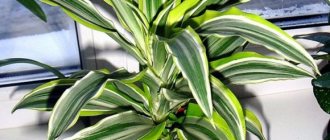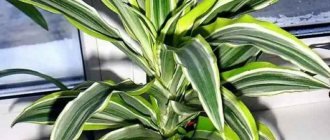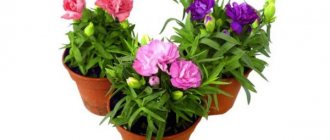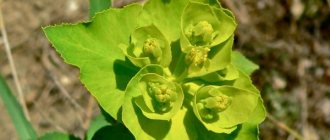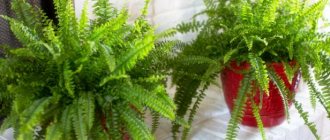In this article, the Site will tell you about the types of dracaena and how to care for it at home: placement, watering, temperature conditions, etc.
- Types of dracaena
- Accommodation
- Watering
- Temperature
- Humidity
- Top dressing
- How to trim
- How to propagate
- How to replant
- Pests and diseases
- Site Digest
Recently, landscaping at home is not just a trend, but an obligatory component of any interior. Beautiful, stylish and useful. Plants look original in compositions, but individually they do not lose their charm. Let's take a closer look at one of these - dracaena.
A spectacular representative of the asparagus family, it grows in nature mainly in tropical and subtropical regions. In her homeland, her name is translated as “female dragon.” This is due to the color of the sap that the plant produces. The dark red gum reminded our ancestors of dragon's blood.
Externally, the plant resembles a palm tree, sometimes a shrub. Most often it has a tree-like shape; the trunks of natural species can reach a diameter of up to 2 meters. Dracaena leaves are dense, linear, lanceolate or belt-shaped, and also oval.
When choosing a plant for your home, you need to consider how much space and light you can provide it with. Among the variety of species there are both giant and compact dracaenas. And if a young plant takes up little space, then an adult plant grows and requires more comfortable conditions. Likewise, different foliage requires different lighting conditions.
Types of dracaena
There are more than 150 plant species. But the most popular for the interior are the following dracaenas:
1. Fragrant - a shrub with arched glossy leaves. They are quite large, growing up to 70 cm in length and 10 cm in width. Varieties of fragrant dracaena are distinguished by the color of the leaves, the size and color of the stripes on them. There are solid green leaves, variegated with a border around the edges or with a couple of stripes. Their color varies from white to yellow. The flower got its name from its delicious aroma during flowering.
2. Marginata (fringed) - a small tree slightly reminiscent of a palm tree. The trunk is smooth and straight, the leaves are hard, linear with pointed ends. In nature, this is a very large, powerful tree, but people have domesticated small cuttings of the trunk, which look no worse and grow up to 2-3 meters. Along the edges of the leaves of dracaena there is a narrow border, most often of a reddish tint, but you can also find yellowish stripes.
3. Deremskaya - a tall tree with a thick tree trunk. Outwardly it is similar to fragrant dracaena, but its aroma when flowering is unpleasant. The leaves are large, lanceolate with yellow, gray, white or green stripes. Their length can reach up to 50 cm, and their width is about 5 cm.
4. Sandera is a bamboo-like plant that, according to Feng Shui, brings good luck and prosperity. This dracaena is perennial; at home it can reach a height of a meter or more. Its gray-green leaves are slightly twisted and grow up to 25 cm in length.
5. Hookera - South African tall dracaena, most often cultivated in greenhouses or in houses with high ceilings. It grows above 2-3 meters, and there are specimens with a bifurcating trunk. Green leaves with light edges grow up to 100 cm long and up to 10 cm wide. They themselves are dense, leathery, slightly tapering at the base.
6. Reflexa (bent) - the most capricious of dracaenas. It grows slowly, needs support and high humidity. With good care it will grow up to 3 meters in height. The leaves are small, arrow-shaped and slightly curved. The edges are painted with a yellow stripe.
7. Godsefa (surculosa) - dracaena-shrub, not similar to the above, but no less picturesque. It produces its new shoots not from the trunk, but directly from the ground. With careful care, it will grow at least a meter and will delight you with pleasant fragrant flowering. Its leaves are more oval, slightly wavy at the edges and slightly pointed at the base. The main color is green; the pattern on the leaves decorates the plant not with stripes, but with a large number of white or yellow spots. With age, the leaves will begin to turn white.
Features of cultivation
Indoor shoot-forming dracaena is relatively unpretentious in terms of growing conditions. Grows well at year-round air temperatures of 18-23 °C. In the winter months, Godsepha can withstand temperatures down to 16 °C; at lower temperatures, it first stops developing and then dies.
The optimal place for a perennial is a windowsill with diffused sunlight. Under the bright rays, Godsefa can get sunburned. In a poorly lit place or on northern windows, the variegated color of the leaves, for which the home plant is so valued, is lost.
To get a beautiful dracaena shape and evenly colored shoots, you should rotate the pot 45° around its axis every 2-3 weeks.
In the summer months, it is recommended to take the bowl with the flower out onto the balcony, loggia or garden plot. Fresh air has a beneficial effect on the appearance of foliage and accelerates the growth of new shoots. It is advisable to maintain the humidity of the room in which Godsepha grows at 70%. The flower should be sprayed only in very hot weather or if it is close to heating appliances. The water must be left to settle for 24 hours so that the leaves do not become covered with limescale.
Accommodation
Dracaena has appeared in your house. Where should it be placed? Any room or insulated balcony is suitable for growing. The ideal option is to place it near an east or west window , but the plant should be kept away from the south. Dracaenas love good lighting, but not direct sunlight. The latter burn spots on the leaves. Try to find a place where the plant will be comfortable.
Experiment, play with the position: look at different areas of the room or place it in another. Do not bring them close to the wall either; the ends may dry out from contact. Artificial light is also suitable for growing dracaena. Often it is necessary to organize lighting in such a way that the crown of the plant is illuminated evenly.
Watering
The soil should have time to dry sufficiently between waterings. Not completely, but half the pot, check with a simple wooden stick or knitting needle. Usually in the warm season the plant is watered once a week , and in winter once every two weeks is enough. But you shouldn’t overdo it with watering; from stagnation of liquid, the plant withers and the roots rot.
Water for irrigation is used tap water, settled or filtered. Once a month, you can give your dracaena a “hot shower” procedure ; the tropical plant will appreciate it and be saturated with moisture. During the shower, so as not to wash away the soil and not to oversaturate the plant with water, cover the pot in a bag and secure the edges. For those who are familiar with this type of watering, you can do without covering the soil. The shower is set to medium or low power, the water is turned on at 60-70 degrees (this is when it’s hot, but your hand can tolerate it) and watered evenly, without getting carried away, for 20-30 seconds. And then they leave it in the shower for two or three hours without turning off the light. You can leave it overnight.
How to water Dracaena
When growing dracaena, caring for it involves timely moistening of the decorative flower. Water the crop regularly, as it is characterized as moisture-loving. The topsoil layer of the soil should never become too dry. Water the crop as soon as the soil layer dries 2-3 cm. Use soft and purified water for this purpose. The best option is settled or melted liquid. Tap water is not suitable for such a crop, because white spots immediately appear on its leaves.
Make sure that the soil in the pot is always moist, but do not allow the liquid to stagnate or become waterlogged. Otherwise, the roots of the dracaena will rot, resulting in the death of the ornamental plant. In summer it is watered daily, and in winter the amount of watering is reduced.
Humidity
To prevent the plant from drying out, a certain humidity is maintained in the house. Only Godsef calmly tolerates dry air from dracaenas; for everyone else, you need to stick to 60% . They especially often humidify the air when the heating is on.
If you see that the plant has begun to fade a little, watering it with a “hot shower”, which we wrote about just above, will help bring the plant back to life. The main thing is to leave the dracaena longer after bathing to saturate itself with the evaporation of moisture. If possible, you can purchase a humidifier.
Top dressing
For dracaenas, feeding is required. Lack of nutrition, especially nitrogen, causes yellowing of the leaves. Therefore, during the growth period - from March to September - it is watered twice a month with complex fertilizers for indoor plants. Do not look for special fertilizers for dracaenas, look at the NPK ratio (nitrogen, phosphorus, potassium), it should be 3:1:3 . Periodically, you can spray with epin or iron chelate.
Edged Dracaena
Dracaena marginata is the most unpretentious representative of the species in question. An ornamental plant with a tree-like trunk is covered with green foliage, which is decorated along the edge with a beautiful red-violet edging. The leaves of specimens of the variety are narrow, and the height when grown in natural conditions varies between 3-5 m. The habitat of the crop is concentrated on the island of Madagascar. That is why its unofficial name is “Madagascar Dragon Tree”.
Dracaena Godsefa
Dracaena Godseph is a subshrub plant with dark green oval-shaped leaves. A characteristic feature of the leaves is whitish-cream specks of varying sizes over the entire surface. Due to their unusual appearance, specimens of this variety stand out effectively among other representatives of the genus.
How to trim
When plants become stretched and lose their outer beauty, they need pruning. It is carried out with a very sharp and disinfected knife . Measure 20 cm from the top of the trunk and cut it at a right angle, immerse the end of the cut in a rooting agent and plant it in a mixture of vermiculite and perlite (drainage is placed at the bottom of the pot). Then cover the cuttings with a greenhouse, any bag will do, and leave for 30 days.
Water such cuttings once a week in a tray without opening it. Cuts on dracaena hemp are treated with crushed coal, cinnamon, or better yet, melted paraffin. Otherwise, they may rot or begin to dry out. You can cover the stump with moss and wrap it in polyethylene, this will help the cut grow faster. After some time, new shoots will appear on the stump. And little by little the beauty of the old dracaena will be restored.
Dracaena propagation methods
Dracaena propagation is carried out in the spring, when the crop begins to actively grow. This occurs in March or April, and among all varietal varieties, bordered, derenskaya and sandera reproduce best.
There are several options for propagating the crop. For example, when pruning a flower bush to form a crown, you can root the cut apical shoot or give preference to propagation by cuttings made from stems. Let's consider each of these options separately.
We propagate dracaena from stem cuttings
Cuttings of dracaena stems are performed when the long top of the crop wilts. To perform the procedure, select a healthy and viable stem on a flower bush. Its diameter should be at least 2 cm. Give preference to elastic planting material. Divide it into parts, the length of which varies in the range of 5-20 cm. Form sections along the line of leaf scars, using a sharp knife for this purpose.
Root the cuttings in a special substrate, preparing it yourself according to the following scheme.
- Select a set of components for preparing the substrate. They mainly use perlite, a specialized soil mixture for cacti and palm trees, sand or hydrogel.
- The formed cuttings can also be rooted in water. The main requirement for the liquid is room temperature, and when the water in the container becomes cloudy, it should be replaced. The procedure is carried out 2 times every 7 days until the roots appear. To keep the liquid fresh longer, add activated carbon (1 tablet).
- If stem divisions take root in the substrate, they are moistened with water before being placed in the ground. The sections are sprinkled with powder, and Epin, Zircon or Ecogel are mixed into the substrate.
Dracaena can be propagated using 2 methods.
- Horizontal. Place the prepared cuttings in a moistened substrate and lightly press it there. Rooting of the crop is carried out in greenhouse conditions, and while it is in the room, the air temperature is maintained at 20-24 ºC.
- Vertical. The lower part of the cutting is buried 2-3 cm into the earthen substrate and sprinkled with a layer of sand 5-6 cm thick. This is necessary so as not to immediately replant the seedling. At first, the formed roots will be in the sand, and a little later they will penetrate deep into the earth.
During horizontal rooting, the stem is gradually destroyed, on which young shoots are formed. When they have formed new roots, due to which the plant will receive nutritional components from the soil, the cuttings are planted in individual pots.
Cuttings from the apical branch
Having chosen to propagate dracaena by apical cuttings, try to properly prepare the planting material for transfer to the substrate. First, cut off the top of the crop, 10-15 cm from the highest point. Make the cut so that it is smooth, beveled or straight. During the procedure, eliminate the possibility of damaging the plant, otherwise it will rot after rooting. Root the cut plant immediately or after pre-withering in the oven. Use the same techniques and soil mixture for this purpose as for stem cuttings.
Be sure to provide the top with optimal care, otherwise it will rot and die. Please note that the prepared substrate contains living microorganisms that gradually destroy the tissues of the planting material. In this regard, it is necessary to observe moderation in the watering process, to prevent waterlogging of the soil and rotting of the roots. If the soil dries out, the living tissues of the cutting will also dry out and the plant will eventually die.
Root the top at an air temperature of +20+22 ºC. After planting, create greenhouse conditions for the material by covering it on top with glass, plastic material or a plastic bag. Be sure to spray the leaves of the seedling three times a day. Once every 7 days, spray with a special solution containing fertilizer for palm trees. This must be done because in the absence of a formed root system, the crop is fed from its leaves.
Cuttings of dracaena from stems and apical shoots have significant differences. When using option 1, germination occurs at both stems and roots. In the 2nd option, the roots sprout only at the top. When propagating dracaena, keep in mind that during the period of formation of the root system you cannot dig up the substrate for the purpose of checking. The rooting process of the cut top takes from 1 to 1.5 months. New shoots are formed within 2 months. If roots have not formed within a given time period, most likely you have rooted the dracaena incorrectly. Repeat the procedure again.
You can find out more in the Indoor Plants section of the website.”
How to propagate
Dracaena propagation occurs by cuttings or growing from seeds . The most favorable time is from February to May.
The seeds are soaked in water for 24 hours, and a stimulant is added if desired. Plant in a container with a diameter of no more than 10 cm, in the ground 1-2 cm from the surface. The soil must be sterilized before planting. The soil is taken special for seedlings or universal. Then cover it with a greenhouse (bag, jar) to increase humidity, open it a couple of times a day. Seeds germinate from 2 weeks to 3 months. With cuttings, the rooting procedure is the same, cut off 7-10 cm of the stem and plant it in the ground. Some gardeners also root in water, but this method takes even more time.
Fragrant Dracaena
Dracaena fragrant is the largest representative of the genus, growing up to 6 m. The plant has the appearance of an evergreen shrub, but when cultivated at home it grows only up to 1-2 m. The fragrant flowers of the plant smell like freshly cut grass and are white in color. The bright green foliage is characterized by wavy and wide width.
We recommend viewing: Peonies - care and planting in open ground, catalog of varieties with photos and names
How to replant
Over time, the soil changes structure, becomes compacted, caked, and the roots do not receive enough oxygen. To avoid this, a transplant is needed. It is held in the spring. Select soil special for dracaenas or mix the soil yourself (in equal proportions - turf, leaf soil, compost and fine gravel); drainage must be placed at the bottom of the pot.
If the plant is less than three years old, replant it every year. Adults, large and slow-growing ones are replanted every couple of years. For very large plants, such as adult dracaenas, replanting is carried out in extreme cases, but the top soil is changed once a year.
You should not immediately replant a purchased plant; let it adapt a little. During the period of flowering and disease, replanting is also not recommended.
Rules of care
All species need to be cared for properly, then you will not face many problems to grow a strong tree.
Lighting
Dracaena (dragon tree) is an unpretentious plant; even a novice gardener can grow it. A tree lives on average 10 years, it all depends on how to care for the plant and what species is grown. At home, the tall plant does well where the temperature is from 21 to 25 degrees.
The temperature should not be allowed to be below 12°C, in which case the indoor specimen will die. In hot weather, it is recommended to take the pot out into the fresh air (balcony or garden), just avoid drafts.
This individual really loves bright light, although dracaena can grow in a shaded place, but only then will the leaves lose their brightness over time.
When the tank is in a shaded place, it sometimes needs to be moved to bright places where sunlight falls well. Just avoid direct exposure to the sun's rays.
In principle, artificial lighting can be created for the plant; it feels quite good in this light. Variegated species require bright light.
Watering mode
During the hot period, the flower must be watered every day; in winter, watering must be reduced. It is recommended to use a moisture meter to monitor soil moisture.
Plant care must be organized correctly. The tree responds well to moisture, but does not like excessive waterlogging, otherwise the root system may rot.
Watering depends on the size of the leaves and the size of the flower. If the plant is large enough, then it needs to be watered more abundantly. There is another method of moistening dracaena - placing the container on wet peat.
Professionals recommend alternating regular watering with wiping the leaves, which can be done using a spray bottle or can be wiped with a wet sponge. Almost every species needs to be moistened, only Dracaena gosdefa normally tolerates dry air.
How to prune correctly?
In order for there to be excellent branching, a young tree that is well rooted and has reached a height of 30 cm needs to be pruned. It is necessary to remove the upper parts (8-10 cm), but in such a way that the leaves remain at the top.
Pruning is done with a knife or garden shears; the objects must be well sharpened. Pruning is done carefully, but if the plant was damaged during the process, then in this case it is worth using garden varnish and covering the wound.
After about a month, thickenings can be seen under the cut, as a result of which new stems will begin to form. If you want proper care, then pruning is directly included in it.
Transfer
The optimal time to transplant dracaena is spring. Of course, you can replant the plant in summer and autumn, but it is best to do this in the spring months (March-April). Young trees need to be replanted once every 2 years, and older trees less often - once every 5 years. And they need to be taken care of impeccably.
After purchasing the flower, you should not replant it immediately; you need to wait the first 2 weeks for the dracaena to get used to the new place.
In order to perform the transplant, large, tall tanks are used. It is recommended to lay a drainage layer at the bottom of the flowerpots. The soil should be loose; it is prepared from the following components:
- turf soil - 1;
- sheet soil - 1;
- sand - 1;
- humus - 1.
You also need to add small bricks and charcoal, as a result of which there will be good water permeability. Small pebbles help improve the structure of the soil mixture, perfectly absorb excess moisture when watering, and charcoal disinfects it.
Fertilizers
You need to care for the plant correctly; this requires fertilizing. It is especially necessary to fertilize the tree during the intensive growth period (from mid-spring to the last week of summer). It is recommended to feed the tree once every 2 weeks. In the autumn season, fertilizers are applied once every 30 days; during cold periods, they are stopped.
It is worth considering that absolutely all varieties of dracaena are extremely demanding of fluoride. This element negatively affects the growth of the tree; the tips of the leaves begin to dry out. When purchasing fertilizer, you need to make sure that it does not contain fluoride.
You should not use phosphorus fertilizers, as they may also contain fluorine. If you water with fluoridated water, you must boil it.
Pests and diseases
Typically pests that attack dracaena are scale insects, thrips and whiteflies. Rarely spider mites and aphids. The plant is quarantined, pests are removed and treated with special preparations (insecticides).
As for diseases, they affect dracaena:
- powdery mildew;
- horny, gray, brown and bacterial rot;
- fusarium, bacteriosis, heterosporosis;
- spotted wilt and some others.
For treatment, damaged leaves and areas are removed , treated with special solutions or replanted. Each case is individual and sometimes require quite a long time. Be patient, follow the recommendations of experts, and you can save your dracaena. In the future, follow the care tips, and then many diseases will be avoided.
Site Digest
Know and be able to: how to grow orchids - We will tell you how to grow and care for several types of indoor orchids at home, which are often sold in stores.
Buying indoor plants: step-by-step instructions. — We buy indoor plants that will grow and delight us for many years. The site will tell you how to make the right choice!
9 cool plants for the home and how to properly care for them - We’ll tell you how to choose simple indoor plants with recommendations for growing different types of indoor plants. Which ones will you choose?
How to repot houseplants - is it time to repot houseplants? We'll tell you and show you how to do it correctly and usefully for our green friends!
11 plants that purify the air in the apartment - Let's talk about 11 plants that purify the air in the apartment and create a pleasant atmosphere. Description of the beneficial properties of plants for your health and home. Beautiful, natural and healthy!
Reproduction
If you provide impeccable care for your tree at home, it will delight you with its beauty. The plant reproduces well from cuttings. Using a knife, you need to cut off the top of the flower and plant it in the ground.
For rooting cuttings, it is necessary to create greenhouse conditions. It must be covered with polyethylene or a cap. The cuttings should be watered every day, the foliage should be moistened with a spray bottle and ventilated. The temperature in the room should be +23°C no lower. The root will form in a month, after which it is allowed to be planted in a container with prepared soil.
Indoor dracaena is also propagated by stem cuttings. The shoot must be cut into pieces of approximately 5 cm, then allowed to dry, and then planted in the soil.
When a side shoot with 2-3 leaves appears, this will indicate that the flower has taken root, therefore, it can be transplanted into a container. Caring for the cuttings must be competent.

